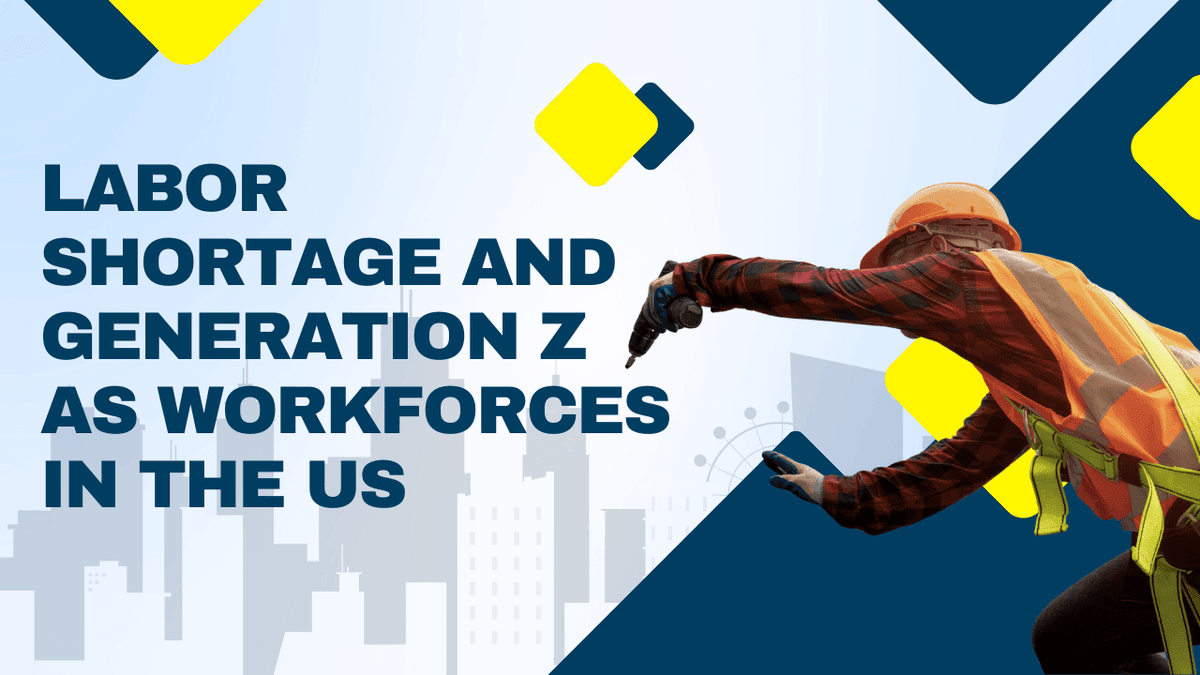Labor Shortage and Generation Z as Workforces in the US
The world is going through a drastic shift in employment and worker demands, and the US is especially suffering from this. Why is America suddenly going through an unfilled job market crisis? A closer inspection would reveal the root of the problem.
by Sheldon Huang
|
Unfilled Jobs: Why & Why Now?
The United States is going through its most severe labor shortage. According to Deloitte.com, America is “expected to have 2.1 million unfilled jobs by 2030.”
To many’s surprises, though the US's job market has been solid and strong for decades. It has been showing signs of slowing down in growth. There has been fewer new jobs added compared to the past, unemployment rates are increasing, and job openings are at their all time high.
The US Bureau of Labor Statistics’ Databases, Tables & Calculators by Subject tool publishes data about the US's job market. the US suffered from a loss of 1,302,000 jobs/employees in March 2020 to April 2020, over a timespan of a month.
Another set of data from the US Bureau of Labor Statistics tells more about job openings in the US. Job openings were at an all time high during April 2021-July 2022, averaging in about 890 job openings per month. That number is an all-time high of all the numbers in the past ten years.
Upon closer inspection at the time, March of 2020 was the time when the Covid-19 pandemic started. The pandemic led to crippling damage in the economy of the manufacturing industry in the US.
Note that the pandemic officially ended in May 2023, according to the announcement from the WHO. Job openings were at an all-time high from July 2021 to July 2022 (averaging about 893 job openings per month). The time is when the pandemic was relatively under control.
People lost their jobs because of the pandemic. No one was filling these job openings even when they're re-opening after the pandemic was under suppress.
This phenomenon is the “Great Resignation,” where people leave their position on a mass scale. According to Deloitte.com, The Great Resignation was a setback that “represents nearly six years of job gains.”
https://gobuidpublic.s3.us-west-

The term “Toolbelt Generation” is referring to the members from Gen Z who are choosing work over studies. They usually prefer acquiring a skilled trades job over pursuing degrees, higher education, and diplomas.
The origin of the Toolbelt Generation, or more so, the belief of “skilled trades and specialized knowledge over college/masters degree,” started nourishing among Gen Z individuals.
From a Gallup and Walton Family Foundation study, 74% of Gen Z teens aged 13-17 identified “going to college” as their goal after graduating high school. This number is “11 points lower than the percentage of millennials who said the same when they were in high school 20 years ago.”
The Toolbelt Generation also approaches work and careers differently from their predecessors, Millennials, or Generation Y.
While the Millennials value career advancements and personal growth, the Toolbelt Generation values more the “life” in “work-life balance” and realistic factors like wages and work hours.
Why is Gen Z Choosing These Jobs?
The Toolbelt Generation is slowly shifting towards skilled trade jobs and saving the US manufacturing industry in the process. Let us make a closer inspection to understand why this is the case.
Some of the most critical reasons for the growth of Toolbelt Generation include: rising education costs and competitive career market. Under these two factors, aiming for a skilled trade career becomes a lot more appealing: more stable, less competition, and no more student loans from college.
Another reason for the Gen Z shift towards skilled trades jobs are for certain key qualities of the workplace. From a McKinsey study, the top five key qualities voted by Gen Z employees to take a job are (in ranking order):
- Reliable coworkers
- Promote honest communication and transparency.
- Enhance a sense of responsibility among employees.
- Meaningful work
- Attach meaning and purpose to work. Some people look for meaning in their work and need a purpose to work long-term with passion.
- Upscale the work to public wellbeing to provide senses of fulfillment and accomplishment.
- Caring leaders
- Leaders and management should not only value work efficiency but also the status of their employees.
- Having caring leaders can also help with employees’ mental health, which can help with employee’s wellbeing and self-growth.
- Workplace flexibility
- Workplace flexibility is extremely important for any age group of employees. Workplace flexibility also helps with achieving work-life balance.
- Inclusive community
- Inclusive communities (one or multiple) give employees a sense of belonging in the workplace.
This can make employees more “sustainable” and prevent burnouts or even workplace bullying.
On top of this, the top aspect for Gen Z employees to stay in a position is “workplace flexibility.” The flexibility that skilled trade jobs offer is likely why Gen Z is shifting towards skilled trade jobs.

Possible Challenges for Toolbelt Generation
The Toolbelt Generation is, to some extent, fixing the labor shortage in the US manufacturing industry. However, members from the Toolbelt Generation are likely to go through certain difficulties while pursuing a career in the industry.
One of the greatest challenges is the use of technology in the industry. The Toolbelt Generation, or Generation Z, is the first generation to grow up with technologies. As a result, the generation is extremely used to using technology, for entertainment, for information, for work - everything.

The industry needs to adopt technology into its work for Generation Z to work in their own way.
Basic aspects like wage can be a difficulty, but when rookies are just starting out in the industry. However, the tools that workers employ on a industry-scale can be career-long detrimental to the productivity of those who are already used to another system of tools.
Possible Solutions
To resolve (or to alleviate) labor shortage in the US, the industry needs to place attention on two aspects: Attracting new workers and retaining old workers.
The newest cohort of workers all belong in Gen Z. The industry should place emphasis on the mentioned workplace qualities and aspects:
Reliable coworkers
Meaningful work
Caring leaders
Workplace flexibility
Inclusive community
Achieving the preceding qualities can tremendously increase the chances of attracting and retaining the newest generation of employees.
As mentioned, many members of Generation Z are beginning to identify “working in skilled trade” jobs as goals once they’ve graduated in recent years. One thing that the manufacturing industry can do is to provide resources to those who are interested.
For example, provide training for rookies that just entered the industry to support long-term career development. Even for those who are still studying, businesses can provide opportunities for internship and vocational programs to help onboard fresh graduates to their future career.
On the other hand, attempting to retain older generations of employees demonstrates some differences than doing so with Gen Zs.
Other than simply “increasing wages,” there are other qualities that effectively retain older workers. According to the Institute for Employment Studies, older workers “value opportunities for learning, mentoring others, and career progression.”
One other factor for workers of previous generations, more important than job satisfaction and job quality, is health considerations. Older workers “place greater value on flexibility at work, adjustments or part-time working hours to accommodate health needs or caring.”
https://gobuidpublic.s3.us-west-1.amazonaws.com/gobuidApi/blog/other/photo/c36395420af54ca99ae64c9da4cb9b67.png
Conclusion
The entire world’s job market is going through a change, perhaps one of the greatest changes ever in the history of job markets.
Generation Z, as the first generation to grow up with technologies, is slowly entering the job market. Certainly, this generation will cause a drastic shift in work culture, workplace environment, and people’s perceptions on careers.
Changes are necessary for industries and workplaces to keep attracting new manpower and retain old ones.
Especially in cases similar to the most recent labor shortage, pandemics, natural disasters, or a new generation of people entering the job market can all change the industry tremendously. The industry should always be prepared to persevere.
